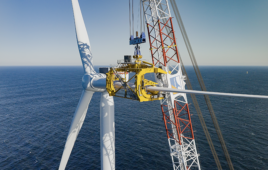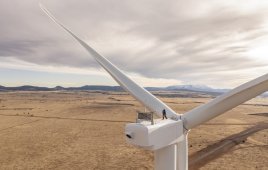Rotor blades, like aircraft wings, are essentially cantilevered beams with aerodynamic exteriors. Early blades were made of wood. More recently, they consist of fiberglass and epoxy resins manufactured by reaction injection molding in rather complex equipment. The quest for greater power will demand longer blades which has led designers to examine carbon fibers as a way to take weight out and increase fatigue life.
Another recent material is a two-component epoxy that increases production of large blades thanks to a new curing agent. To assure that blade molds fill completely and fast, the epoxy reacts slowly at first. Heat applied later speeds the curing and releases the part for production of the next blade in a shorter period than previously possible. Hence, cycle times for blade manufacturing can be cut by up to 30%. Production becomes more flexible because the new resins work over a broader temperature range than conventional products.
In the wind industry, coatings are aimed mostly at blades because they are constantly moving in air and exposed to the weather. However, there are coatings for towers and bolts as well.
Pitting in blades can roughen the surfaces enough to create unstable harmonics that decrease the turbine’s efficiency, while increasing maintenance and repair costs. in steam turbines, pitting or corrosion can cause cracks in the metal. Coating wind turbine blades can prevent the damage. Manufacturers of metal coatings suitable for the wind industry say they are durable, cost-effective, and eliminate common delamination and pitting problems. The coatings spray or roll-on to ensure coverage that’s resistant to harsh weather. Manufacturers say the resins can be applied to almost any substrate. The resulting surface is said to look and wear like cast metal without the traditional expense and weight. The manufacturer says the metal coating does not conduct electricity, is non-corrosive, and can be finished, sanded, polished, brushed, machined, or given a patina just as any forged or cast metal.
Another blade surfacing material uses fluoropolymers in a film application. The manufacturer reports that its advantages include 20-year performance, longer than traditional paint and gelcoat. The chemistry and nanotechnology has been developed to meet the needs of modern wind-turbine blades and has proven longevity in demanding architectural tasks. its performance advantages include absolute UV stability, minimal dirt pickup, excellent abrasion resistance, and low reflectivity.
Trained technicians can apply the coating quickly, easily, and with little equipment. There are no sprays, solvents, or mixing so the surface quality is not at risk from human error and the working environment is far safer.
Another coating in flake and powder form, actually a high-temperature resistant thermoplastic, has a higher share of hydroxyl end groups to make it polyethersulfone compatible with high-performance epoxy resins. Composites based on such high-temperature-resistant epoxy resins usually stay brittle unless modified with heat-resistant impact modifiers. A recent powder form allows using it more easily in the resin. its use requires no solvents.
Filed Under: Blades, Components





How are blades changing? Blades are getting longer. Some are bending back at the tips under the force of the wind. The profiles are changing. Some are more narrow and all are thinner. Much can be said about all of these. It is especially of interest whether blade length is resulting in diminishing returns and is approaching a maximum practical final value. Someone once said that wind turbine blades fabricated from composites can be made to be operable in lengths of up to one kilometer. This is just to spend a minute or two on some of the questions that are under review in the current state of the art. See the website for even more.